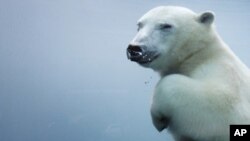New research into the genetic history of polar bears has revealed that the Arctic region's biggest carnivore evolved as early as 600,000 years ago - making the species five times older than previously thought. That longer evolutionary timeline helps explain how the polar bears' ancestors were able to colonize and adapt so successfully to the harsh Arctic conditions.
Earlier studies had placed polar bears' evolutionary emergence at between 150,000 and 200,000 years ago, and suggested close genetic ties with their evolutionary cousins, brown bears. The new research challenges those earlier studies, concluding that polar bears are more genetically distinct from the brown bear and other bear species.
A team of international scientists based its new findings on an analysis of inherited genetic markers - so-called nuclear DNA - from both male and female polar bears and brown bears. In contrast, previous studies used DNA samples taken from only one bear parent. Results from these studies led scientists to believe, erroneously, that polar bears evolved recently, which made their extensive physical adaptations to the extreme conditions of the Arctic surprising to many biologists.
Researching the evolutionary history of polar bears is unusually difficult because the animals spend virtually all their lives on sea ice. When they die, their bodies usually sink to the sea floor, so fossil remains have rarely been found.
The authors of the new study say extending polar bears' evolutionary history by another 400,000 years makes the animals' highly specialized features - such as its oily, water-repellent fur, black skin and fur-covered feet - seem much less remarkable.
The scientists say the results of the polar bear genetic survey also shed new light on conservation issues regarding this endangered Arctic giant.
The new study is published in the journal, Science.
Polar bears live only in the high northern latitudes of the Arctic Circle, which includes regions of the U.S. state of Alaska, as well as Canada, Russia, Denmark-governed Greenland, and Norway. Polar bears in the wild can live up to 25 years. The huge Arctic-dwelling bears can weigh up to 635 kilograms and reach three meters in height - about twice the size of a fully-grown tiger.
Contrary to how they appear, polar bears are not really white. Their fur actually is hollow and colorless. The bears look white because each hollow shaft of fur reflects the light of the predominantly white arctic landscape.
The World Wildlife Federation says the loss of Arctic sea ice due to global warming poses a major threat to polar bears, which spend the majority of their lives on the frozen ecosystems. The animal conservation organization says climate change due to global warming creates extended ice-free periods in the Arctic, which strands polar bears onshore and unable to hunt. Other threats to the endangered species include pollution, industrial disturbances and poaching.
News
Genetic Survey Shows Polar Bears Evolved Far Earlier Than Previously Recognized





